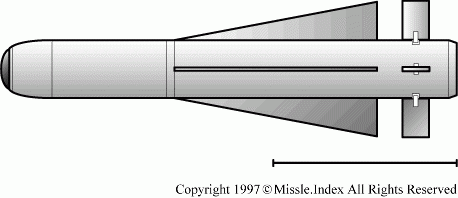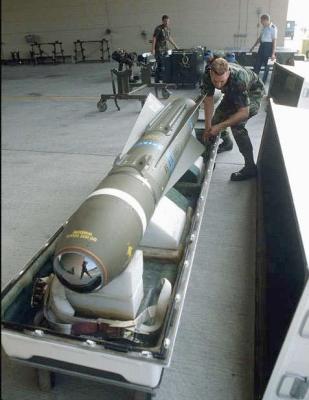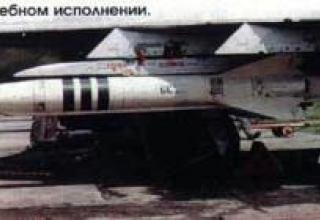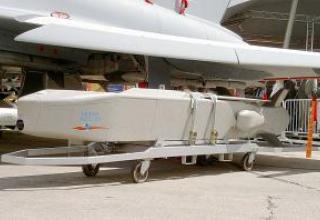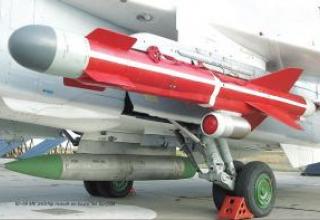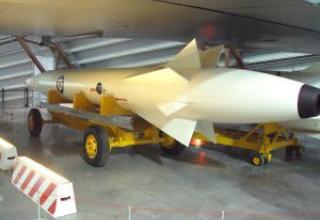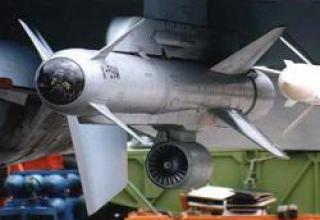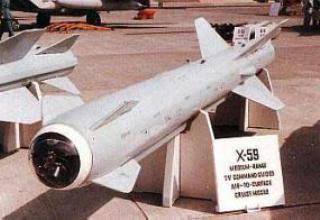"Maverick" AGM-65D - a modification of the tactical missile "Maverick" AGM-65A class "air-surface", equipped with a thermal imaging head homing. It was developed by the American company "Hughes Aircraft Co" and adopted for service in 1986. The missile is designed to engage a wide range of targets. In addition to armored vehicles with engines running or recently turned off, aircraft at airfields, which are quite powerful sources of heat, guided missile ASM-65D can also be used on artificial structures, contrasting in thermal respect to the background of the ground.
The goal of AGM-65D was to overcome the limitations on combat application inherent in early modifications of the same TV-headed homing missile - AGM-65A and AGM-65B.A "M-65D missile can be used both day and night in simple and difficult weather conditions, including the presence of smoke and dust over the battlefield. Besides, all other conditions being equal, its homing head can capture a target at a range of 9-12 km, i.e. almost twice as big as the TV heads of A "Ì-65A and A "Ì-65B guided missiles. In winter, the possibility of its application is reduced only by 10-12 %, not by 70 %.
Composition:
All variants of the "Maverick" rocket have the same normal aircraft aerodynamic scheme and are equipped with a 2-mode solid fuel engine TCh- 481. In the starting mode it develops a thrust of 4540 kgf, and in the marching mode - 990 kgf. The total thrust pulse is 6160 kg, engine run time is 3.5s.
Thermal imaging CNS is made as a removable module, which makes it possible to replace it with other types of heads.
The SOS target coordinator includes an optical system and electronic components for processing infrared (IR) signals and developing control commands. The natural thermal radiation generated by the target and the surrounding background in the infrared spectrum, through the lens input window and the deflector mirror of the optical system enters the scanning device. Its inner ring surface is formed by 20 narrow mirror plates that are mounted at different angles to each other. Thanks to this, when the device rotates at 60 rpm, a line-by-line view of the CNS field of view is performed. The image reflected by the mirrored plates goes to the IR detector grating, which is cooled down to ultra low temperatures to achieve sufficient sensitivity of the CNS. Video signals captured from the grid output are fed into a raster-scan indicator, which is placed in the cockpit.
When using the "Maverick" AGM-65D for search and primary target detection uses the existing on board the aircraft carrier infrared forward vision station, and if it is not available - the thermal imaging head of the missile. A crosshairs and a rectangular target acquisition grid are superimposed on the image displayed on the aircraft indicator. When it is detected, the IR station or the thermal imaging CNS switches to a narrow field of view mode. The reticle is then superimposed on the target, and after it is captured by the head (in the range of allowed ranges) the missile is launched.
Further homing is performed by two methods - centroid detection and autocorrelation. The first method is used if the target occupies less than 60% of the body angle of view of the head. The CNS coordinator performs automatic determination of the phase center of the target image by its silhouette and pointing at this center. When approaching the target at a time when it begins to occupy more than 60% of the body angle of field of view, the head automatically switches to the autocorrelation mode of tracking and guidance, which produces a frame-by-frame comparison of the image with the definition of the value of autocorrelation function and the development of guidance error signals, worked out by the autopilot.
Transparent for infrared rays CNS fairing, made of zinc sulfide, can become unusable as a result of erosion caused by particulate matter and atmospheric precipitation when the protective cover is broken off during training flights of aircraft with suspended missiles "Maverick". To extend its service life, a special elastic plastic coating has been developed. It is applied by gas discharge polymerization in the form of a thin film 5.4 μm thick, which impairs the transparency of the fairing by only 3%.
The missile's shrapnel-flag warhead weighing 135 kg has a massive steel case, inside which a powerful explosive charge is placed. The design of the hull eliminates its ricocheting and due to its heavy weight provides penetration of the target (the ship's hull or concrete slab), and the explosion of the BB is carried out with some deceleration, which is selected depending on the nature of the target.
Characteristics:
| Airplane carrier | А-10, F-15E, F-16 |
| Missiles flight speed, km/h | 1150 |
| Flight range, km | 27 |
| Range of target acquisition of CNS, km | 9-12 |
| The length of the rocket, mm | 2490 |
| The diameter of the rocket body, mm | 304.8 |
| Wingspan, mm | 711.2 |
| Start weight , kg | 218.25 |
| Weight of combat unit, kg | 135 |
| Engine weight TX-481, kg | 47.20 |
Testing:
Evaluating the results of the combat application of "Maverick" missiles with TV homing heads in Vietnam (A "Ì-65A), during the operation "Desert Storm", during flight tests and training launches (A "Ì-65A and A "Ì-65B) specialists note that these missiles have quite high accuracy. According to their calculations, the probability of a guided missile hitting a small target (tank, APC, etc.) was 85% on average. However, it is emphasized that such an indicator was achieved under favorable conditions (only during the day and with good visual visibility of the target), in which it is possible to use guided missiles with TV homing heads. This imposes great limitations on the use of missiles in Central and North European theaters of war, especially in winter, due to a significant reduction in daylight hours, frequent fogs and precipitation. Therefore, it is only possible to effectively use guided missiles with television homing heads during this period in 30% of daylight hours.
Sources:
- Дмитриев В. "Управляемая ракета "Мейверик" с тепловизионной головкой самонаведения", Зарубежное военное обозрение,N3, 1983.
- Сергеев Е. "Боевое применение УР "Мейверик"", Зарубежное военное обозрение,N10, 1986.

